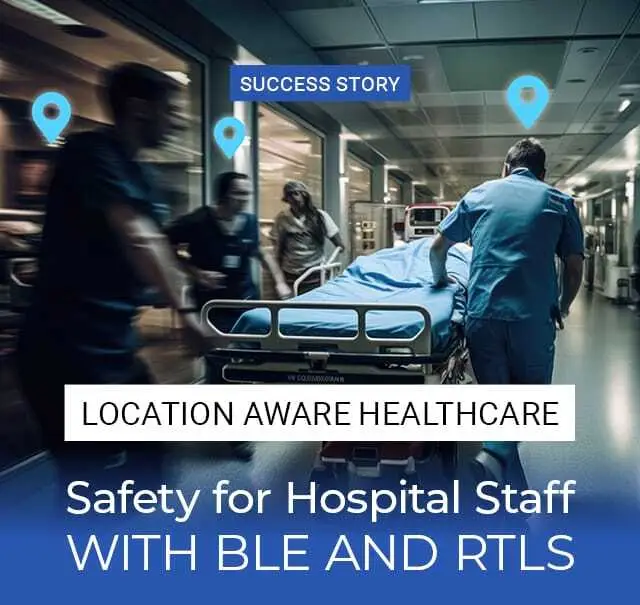What are Bluetooth Beacons?
BLE beacons are small wireless transmitters that use Bluetooth Low Energy (BLE) to broadcast short signals to nearby devices. These signals are picked up by smartphones, tablets, or gateways to provide location data, trigger actions, or deliver information. All modern smartphones support Bluetooth LE. BLE beacons come in various formats such as cards, wristbands, stickers, USB sticks, key fobs, or badges, and can be battery-, USB-, or mains-powered.
BLE Beacon Products
How do Bluetooth Beacons Work?
Bluetooth beacons operate much like a digital lighthouse. Just as a lighthouse emits light signals to guide nearby ships, beacons continuously transmit small packets of data over Bluetooth Low Energy (BLE) at set intervals. These signals are called advertising packets and are designed to be received by nearby Bluetooth-enabled devices—such as smartphones, tablets, or gateways.
Important: Beacons do not receive signals or collect user data. They only transmit data outward. Tracking and interaction occur only if a receiving device (e.g. a phone with an app) is actively listening and interpreting the signal.
What's Inside a Beacon Signal?
Each advertising packet typically includes:
- A Unique Identifier (UUID): A string of numbers that identifies the beacon or the application it belongs to.
- Major and Minor Values: These provide more detailed location data. For example, in a store chain, all stores might share one UUID, while each store has its own major value, and each aisle its own minor value.
- Tx Power (Transmission Power): Indicates the signal strength at one meter from the beacon—used to estimate proximity.
Depending on the beacon standard (iBeacon, Eddystone, AltBeacon), the structure and content of these packets may vary slightly. Some standards allow additional data types, such as URLs or telemetry data.
How Do Devices Use This Signal?
Devices like smartphones with a compatible app or built-in functionality detect the signal and interpret its data. This process enables:
- Proximity detection: By measuring the signal strength (RSSI), the app can estimate how close the beacon is.
- Triggered actions: The app might push a notification, load content, or initiate another action based on proximity or location.
Ranging: Estimating Distance
Using RSSI (Received Signal Strength Indicator), the app classifies proximity into four zones:
- Immediate: Within a few centimeters.
- Near: Around 1–3 meters.
- Far: More than 3 meters, but still detectable.
- Unknown: No reliable signal or undetermined state.
The accuracy of this distance estimation depends on environmental factors such as walls, furniture, signal interference, and the placement of the beacon.
One-Way Communication — But Smart
While beacons themselves are one-way transmitters, they can still enable smart, dynamic interactions when integrated with cloud services, apps, or middleware platforms. For example, combining beacon data with AI in a mobile app can trigger personalized messages, guide users through a building, or enable automation in smart factories and logistics.
Key Benefits of Bluetooth Beacons
Bluetooth beacons offer a powerful combination of simplicity, flexibility, and efficiency. Key advantages include:
- Low Power Consumption
BLE beacons are designed to run for months or even years on small batteries. - Affordable and Scalable
With low production costs and simple installation, beacons are ideal for large-scale deployments in retail, logistics, healthcare, and more. - Easy Integration with Mobile Devices
All modern smartphones support Bluetooth Low Energy, enabling immediate compatibility without special hardware. - Flexible Form Factors
Beacons come in many shapes — from wearables to wall-mounted devices — making them suitable for diverse environments. - Support for Proximity and Indoor Positioning
Enables location-aware services in areas where GPS fails, such as inside buildings or underground facilities. - Interoperability and Open Standards
Multiple open and platform-based standards are supported, increasing hardware and software compatibility. - One-Way Simplicity, Smart Results
Beacons transmit only — no sensitive user data is collected by the device itself. Interaction is app- or server-driven.
Partners Specialized in BLE Beacons
What Are the Beacon Standards?
Bluetooth beacons follow specific standards that define how they format and transmit data. The three most common are iBeacon (Apple), Eddystone (Google), and AltBeacon (Radius Networks).
- iBeacon was introduced by Apple in 2013. It uses a unique ID along with major and minor values to define locations. It’s supported on iOS and Android, but the official iBeacon label requires Apple licensing. Proximity is estimated using signal strength.
- Eddystone, launched by Google, offers more flexibility. It supports multiple frame types like UID (identifier), URL (link), TLM (telemetry), and EID (secure ID). It can work without a dedicated app and is well-suited for infrastructure and public-facing applications.
- AltBeacon is an open-source alternative developed by Radius Networks. It offers similar features to iBeacon without licensing restrictions, making it a flexible choice for custom deployments.
These standards are often supported simultaneously by modern beacon hardware to maximize compatibility.
Applications That Use Bluetooth Beacons
Bluetooth beacons are mainly used for applications in location tracking and proximity awareness. They are increasingly being utilized across various industries. In retail marketing, beacons can present customers with coupons and rewards as they approach a beacon that is located within a store. This enhances the shopping experience for customers.
In the events sector, beacons are used in small business gatherings and in large-scale events like sporting competitions and musical concerts. These beacons provide real-time updates to event attendees. Another application is asset tracking within buildings, where beacons help monitor the location of valuable items.
Beacons also play an important role in indoor location services and indoor navigation. They are used to guide people inside buildings where GPS is ineffective. In the tourism industry, beacons optimize visitor experiences in museums and guided tours by providing contextual information and interactive content as they approach the installed beacons.
Example 1: Tracking Throughout the Entire Life Cycle – This is the New Standard!

The southern German bike manufacturer Iko Sportartikel Handels, known for its 1A brand Corratec, is now making it even easier for its customers to quickly find their bike again thanks to an integrated module. Owners locate the lost item via the Apple Find My network – and they're ready to go!
The e-bike tracker (BLE beacon) is fully integrated into the bike's motor cover and is powered by the e-bike's battery during the normal charging process. This is truly an ingenious solution, as it can be used by the end customer over the entire life cycle of the bike. And that's not all: The tracker also has its own battery, which ensures operation without recharging for up to a year.
The southern German bike manufacturer Iko Sportartikel Handels, known for its 1A brand Corratec, is now making it even easier for its customers to quickly find their bike again thanks to an integrated module. Owners locate the lost item via the Apple Find My network – and they're ready to go!
The e-bike tracker (BLE beacon) is fully integrated into the bike's motor cover and is powered by the e-bike's battery during the normal charging process. This is truly an ingenious solution, as it can be used by the end customer over the entire life cycle of the bike. And that's not all: The tracker also has its own battery, which ensures operation without recharging for up to a year.

With the C-Finder, the Corratec brand offers its e-bike customers the certainty of finding their bike again if it is lost. Dealers are given another quality feature as a sales pitch: Worldwide tracking of their own bikes via the Apple Find My network. And true to the Corratec motto ‘We are young, wild and free’, the end customer can enjoy using their bike without any worries.

Jochen Vogt
COO & Managing Director
Example 2: Porto - Mobile Payment Solutions in Public Transport

BLE (Bluetooth Low Energy) technology opens up new areas of application! While BLE beacons have so far mainly been used for location-based services, a revolutionary opportunity is now opening up in the field of mobile payment solutions for local public transport.
Previous technologies in transportation, based on Wi-Fi, 3G/4G, QR codes or NFC, were already impressive. But now, BLE is setting a new benchmark! Researchers at the University of Porto have investigated the necessary features of BLE beacons for this application in exciting laboratory tests.
The implementation of this innovative solution took place in a one-year test phase and was challenging, but ultimately successful. The new mobile ticketing solution was initially implemented in four selected metro, bus and train lines in the Porto area and gradually expanded. And in June 2018, just one year after the start of the test phase, the system was extended to the entire Porto public transport network!
With these groundbreaking innovations, we are taking a giant leap towards a seamless, efficient, and completely user-friendly mobility solution!
BLE (Bluetooth Low Energy) technology opens up new areas of application! While BLE beacons have so far mainly been used for location-based services, a revolutionary opportunity is now opening up in the field of mobile payment solutions for local public transport.
Previous technologies in transportation, based on Wi-Fi, 3G/4G, QR codes or NFC, were already impressive. But now, BLE is setting a new benchmark! Researchers at the University of Porto have investigated the necessary features of BLE beacons for this application in exciting laboratory tests.
The implementation of this innovative solution took place in a one-year test phase and was challenging, but ultimately successful. The new mobile ticketing solution was initially implemented in four selected metro, bus and train lines in the Porto area and gradually expanded. And in June 2018, just one year after the start of the test phase, the system was extended to the entire Porto public transport network!
With these groundbreaking innovations, we are taking a giant leap towards a seamless, efficient, and completely user-friendly mobility solution!

Example 3: BLE Beacons in Clinical Operations

The University Medical Center Schleswig-Holstein (UKSH) has implemented a scalable Bluetooth Low Energy (BLE) infrastructure in collaboration with Hypros and HPE Aruba Networking. BLE beacons are used to digitize and streamline hospital workflows — including bed cleaning requests at the push of a button, real-time tracking of medical equipment, patient localization via telemetry devices, and monitoring pharmacy box logistics.
Over 1,600 hospital beds are equipped with BLE beacons to save staff time and reduce manual communication. In addition, BLE enables real-time alerts for temperature-sensitive medications and supports safe, efficient patient care. Combined with Wi-Fi coverage, the BLE infrastructure forms a robust digital foundation for modern healthcare operations.
The University Medical Center Schleswig-Holstein (UKSH) has implemented a scalable Bluetooth Low Energy (BLE) infrastructure in collaboration with Hypros and HPE Aruba Networking. BLE beacons are used to digitize and streamline hospital workflows — including bed cleaning requests at the push of a button, real-time tracking of medical equipment, patient localization via telemetry devices, and monitoring pharmacy box logistics.
Over 1,600 hospital beds are equipped with BLE beacons to save staff time and reduce manual communication. In addition, BLE enables real-time alerts for temperature-sensitive medications and supports safe, efficient patient care. Combined with Wi-Fi coverage, the BLE infrastructure forms a robust digital foundation for modern healthcare operations.

Together with Hypros and HPE Aruba Networking, we have made UKSH digitally future-ready and significantly relieved our staff. Ultimately, it’s our patients who benefit most – and that’s what truly matters to us.

Rudolf Dück
CIO
-über-Wi-Fi-HaLow-400.webp)












